Molela Clay Work: Borne of Beliefs
Molela clay work, or Molela pottery’s story starts with a local legend. The potter (kumhar) community living there believes that their ancestors originally belonged to Abu in Rajasthan. They then moved to Nadol and then eventually shifted to Molela. And now, while their main deity and temple is still located in Nadol, they themselves have been settled in Molela for the past 10-15 generations due to a special reason. This special reason is God Devnarayan. Devanarayan, also known as Dharmaraj, is the local god and caretaker of justice. He keeps a tab on the karma of every person in the region.
The early Kumhar community created regular pottery wares like earthen utensils and pots. But their shift to Molela changed their destiny. It is believed that long, long ago, one of the kumhar ancestors was a blind potter. God Devnarayan appeared before him in a dream and asked him to make an image of him. The blind potter replied that he could not do so since he was blind. And so, god Devanarayan nevertheless told him to dig clay from a particular location near the river and then make an image of him. The god assured him that if he made this pottery, there would always be an unending demand for it.
Miraculously, the next day when the blind potter woke up, he could see again! Ever grateful to God, he made a unique type of pottery with the image of Devanarayan on it.
This pottery was the first Molela Pottery. Due to its religious votive nature, it is also locally called as Murtikala.
A Special Place, A Special Man
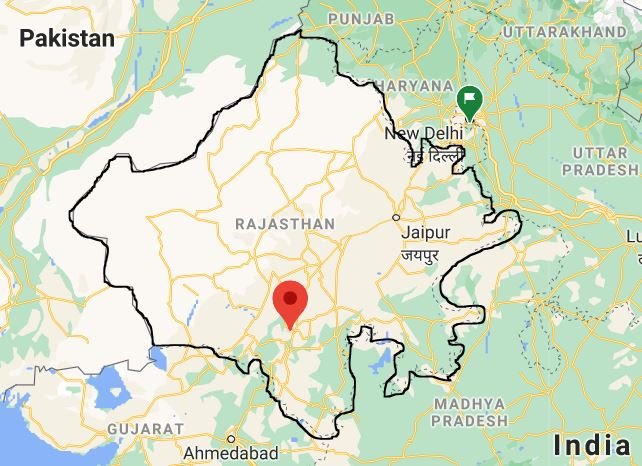
Molela is a rustic little village located near Udaipur in Rajasthan. The Banas river flows near it. And to this little village belongs the famous Molela pottery which now has the Geographical Tag attached to it. Molela Clay Work is unique in many respects. First, it is one of the few pottery styles which is made on a flat slab-like base or plaque. And second, this is a rare type of pottery which does not use a potter’s wheel at all. It is completely hand-made. The three-dimensionality and vivid expressions of the images on the pottery are also in a class of their own. And lastly, for a pottery work of its style, Molela work is surprisingly light.
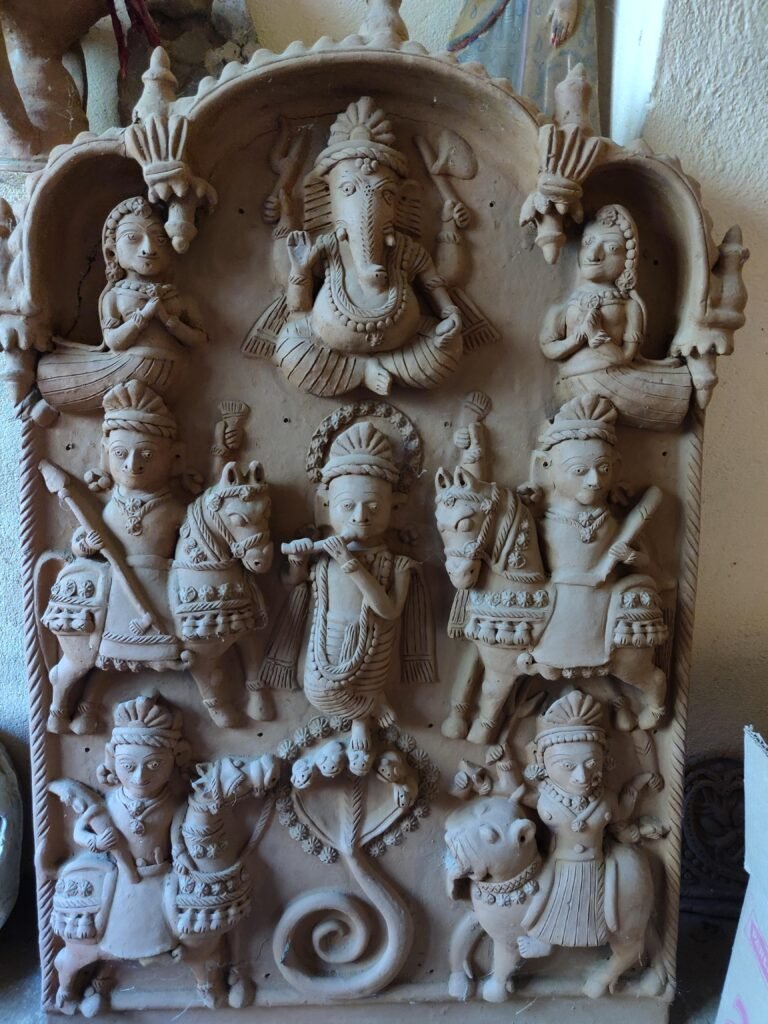
We have been very lucky to have been able to visit Molela. Upon entering the village, we immediately visited the grand old man of Molela, Mohanlal Chaturbuj Kumhar. His family has been making Molela pottery since fifteen generations. And along with his brothers and community, he is responsible for putting this tiny village on the global traditional art map.
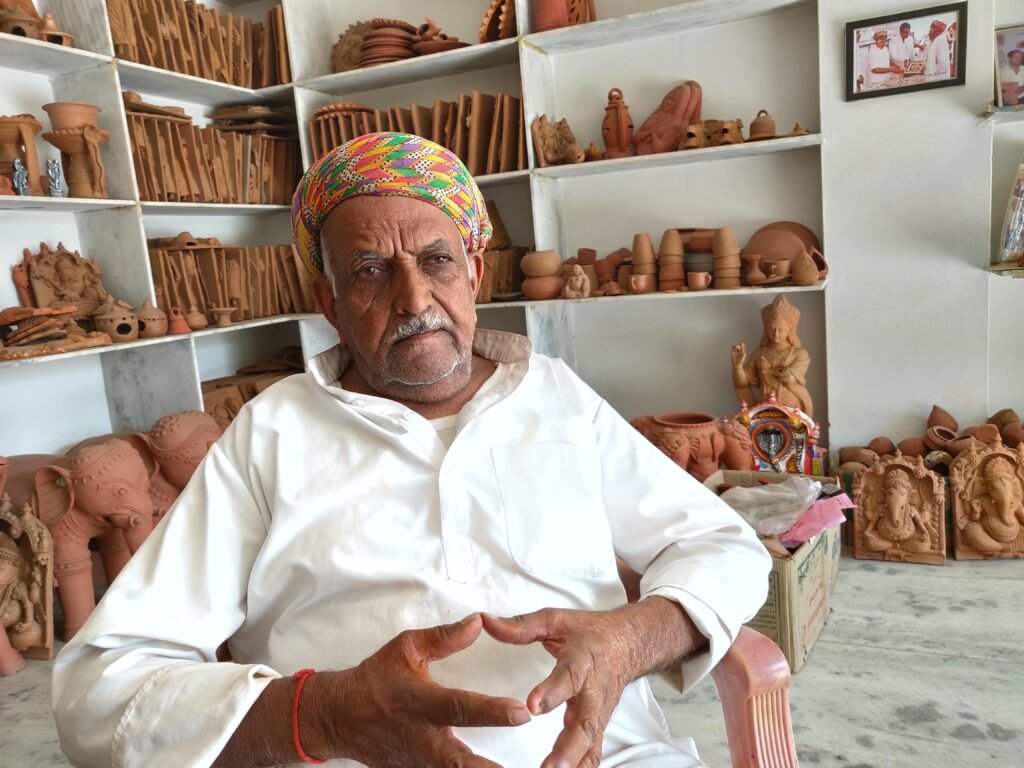
Mohanlalji has spent his entire lifetime working on Molela clay pottery, ever since the age of 10! He holds a record of covering an entire wall of the nearby railway station with Molela plaques. And he has won around 40 national and state awards for his work, and was kind enough to show us his Padma Sri and Shilp Guru awards. Just holding them left us in awe, as well as the fact that Mohanlalji has his very own wall containing all his awards and pictures. We call it his Wall of Fame.
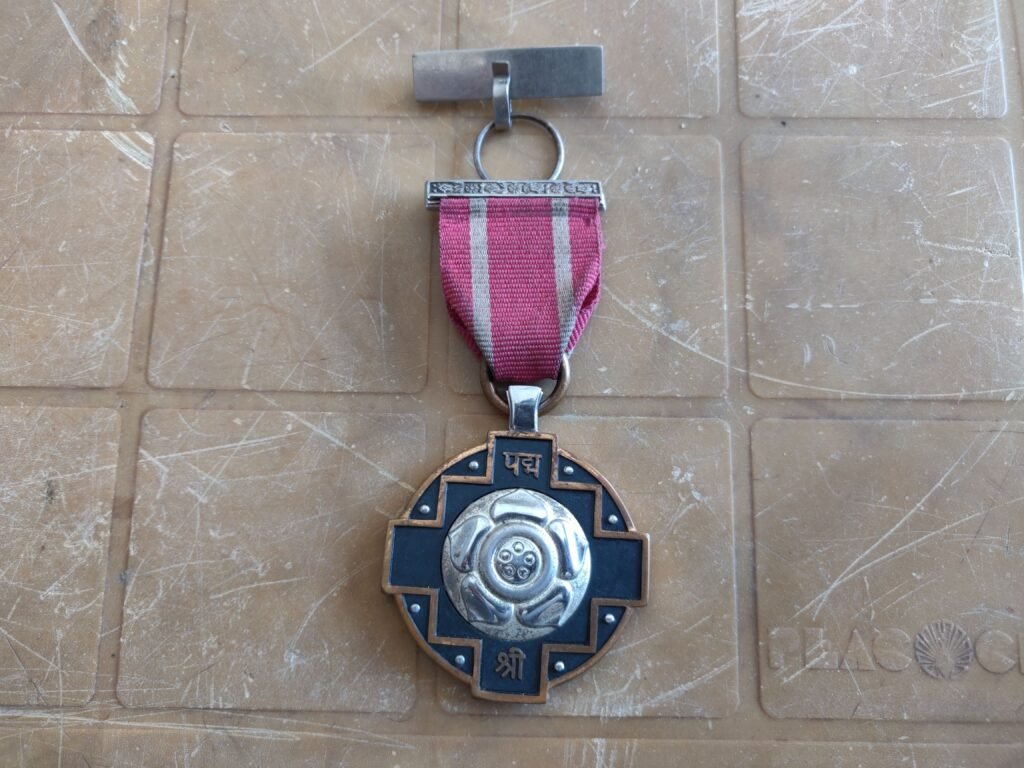
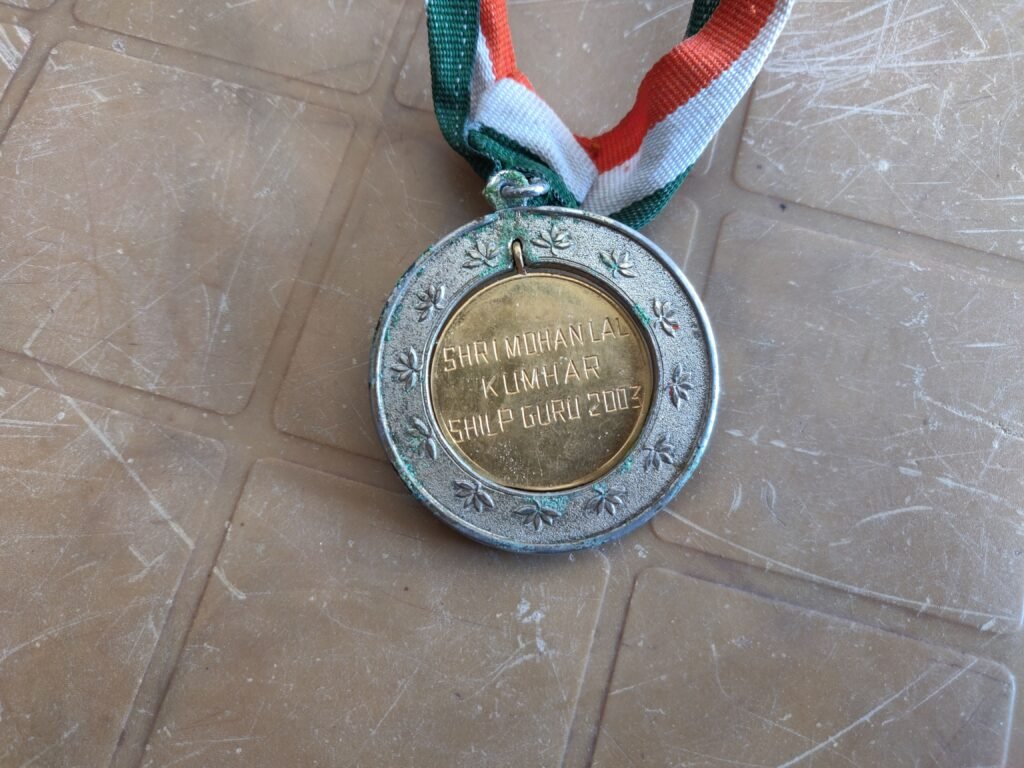
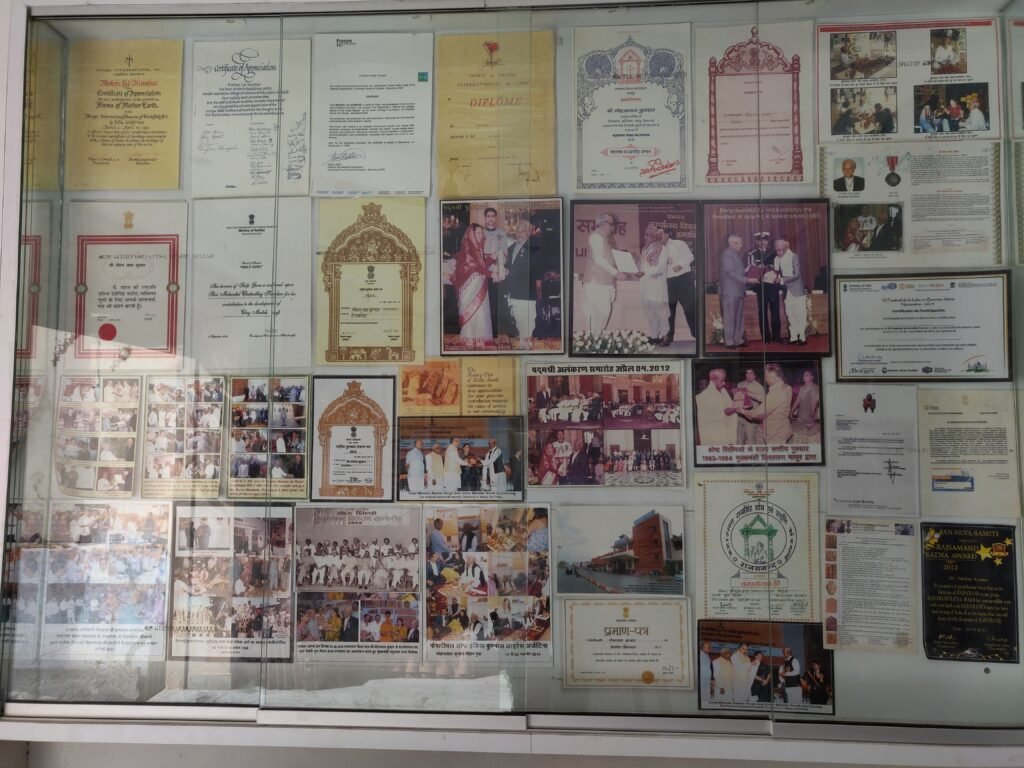
Paraphrasing Lestrade’s line from BBC’s Sherlock Holmes, ‘Mohanlalji is not only a great man, he is a good one too.‘ He has been the inspiration, mentor and trainer for hundreds of artisans in Molela village to make Molela art. In doing this, he has not only inspired the village’s economic empowerment, but also an entire new generation to continue a centuries old traditional artform.
From Mohanlalji, we found out more details of Molela pottery and about each of these unique points.
Making of the Molela
It is difficult to imagine how something so intricate can be made out of clay. But the unique technique of making Molela pottery makes the whole process seem so simple. Mohanlalji’s son was kind enough to show us the steps of Molela clay work.
1. Clay Preparation
As you can see in the video above, artisans procure the clay from local ponds and the sieve it to get rid of large impurities. This sieved clay is then mixed with donkey dung and water to prepare a dough (Rajasthan has one-fifth of India’s donkey population). This dough is kneaded with hands and feet and stored for 2-3 days. The kneading with feet had a sort of deftness that left us spellbound. Check it out below.
2. Creating the Base
The base of the molela clay work is called a thaal. To create this, a ball of the kneaded dough is taken and flattened with a round stone tool called a pindi.
The flattened dough is further smoothed with a wooden tool called paata. The usage of water is instrumental here. Water is used at every steps to smoothen the clay.
The thaal is given its final shape using a metallic tool called bhaladi to scrape away extra clay. A rectangular frame is used for reference. In this way, the thaal or base is ready.
The base or thaal of the molela plaque is sometimes decorated with a border called a doli. For this, rolled clay is smoothened and applied to all sides of the thaal with water. Preparing the border first helps the artisan to decide the size of the internal shapes of the pottery.
3. Designing the Main Body
The next step is to take thin flat slabs of clay and use the clay relief technique to create the body of the deities or other main characters. The thin slab is roughly shaped with the metallic tool bhaladi after which it is stuck to the thaal. The interesting thing is that the molela plaque remains light because the main figures of gods and goddesses are made in such a way that they are hollow!
4. Adding Subsidiary Features
Once the border and main body decides the overall spatial layout on the plaque, the artisans next make the finer subsidiary features like face and legs of the deity, along with background details like trees and animals.
Molela pottery is famous for its highly emotive figures. Watch how the addition of hands suddenly brings the village woman to life!
Once these are created, the rest of the surface is pressed with wet fingers to even out the background. Even finer details are added, like the tiny necklace below.
5. Decoration
Now that the basic work is done, detailed decoration is done using the metallic bhaladi. The broader front end is used to make bigger lines, like the folds of a skirt. The finer back end is used for finer details, as shown below.
6. Drying and Baking
The prepared molela plaques are finally dried in the sun for 4-14 days. This step is important because any leftover moisture in the clay would cause the plaque to crack upon heating in the kiln.
The dried plaques are stacked carefully in an open kiln and then baked for around 4 hours using babool wood. This is a tedious process where someone has to feed the fire every 10-15 minutes. The temperature of the fire also has to be regulated to 900 degree centigrade. Fortunately, the baking process is often a community effort and artisans take turns to look after the entire process.
7. Cooling and Repair
The baked pottery is then cooled for 5-6 hours. Any cracks in it are repaired with a mix of ground fired clay and water (for larger cracks) or glue and water (for smaller cracks).
8. Coloring and Varnish
Based on the demand of customers, plaque may be colored using a slip made of pre-baked clay, water and colored minerals. The typical colors used are vermillion, yellow, black, green, light blue and white.The plaques are first painted white, and then painted with colors mixed with gum for the local babul or keekar trees. The brush used for painting is made using hair from a donkey’s tail.
Since the plaques are religious in nature, only a special type of lacquer made of plant gum and oil, called jala is used for varnishing. Only a few families within the community produce jala.
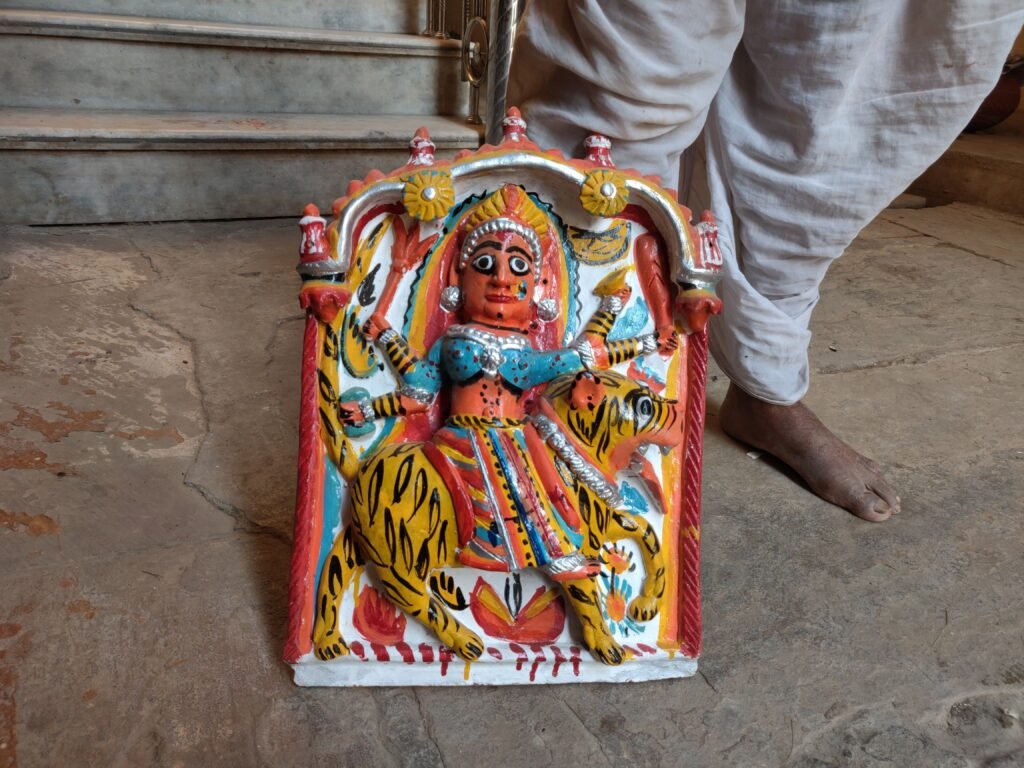
Demand and Supply
Historically, the craft thrived especially in January and February when the Bhil tribe members from Madhya Pradesh would visit the artisans and ask them to make slabs of their specific gods. This is how votive figures were the primary theme of the Molela pottery. The main gods were Devanarayan on a horse holding a spear and a lotus. Other gods are accomplices of Devnarayan like Yamaraj, the god of the dead, Bhairon in two forms— dark and ferocious, fair and compassionate, Ganesh, Durga, Sheshavatar, the serpent god Nagdev, etc. Usually, a priest accompanied the tribal to advise him on which god would benefit them the most. This Molela pottery would then be bought by the Bhils and worshipped at home.
Thus, Molela pottery not only bound clay together, but also three communities— the artisans, the tribals and the priests.
Along with gods, local heroes also featured on the plaques, like goddess sisters Lalbai and Phulbai, or the spear holding brothers Bhunji and Mahenduji and Ratna Rabari.
In recent times, market forces have also encouraged the artisans to introduce village themes and their everyday lives into the pottery. These pieces very often feature surrounding animals, human activities and trees. Here are some examples from Mohanlalji’s place.
Here’s Chandralalji explaining one of his Molela clay work to us.
Modern Issues
Molela pottery is slowly losing the grandeur of its old days due to lack of awareness of this grand artform. In addition, the special soil from the river banks and ponds, which is instrumental for creating the pottery, is being ruined by forces from the brick-making industry in the region.
Will Molela need another godly intervention to survive? I don’t know. All I know is that beautiful art like Molela, and beautiful people like Mohanlalji and his son deserved to be cherished and remembered forever.
If you would like to contact Chandralalji and enquire about Molela, please message us below.
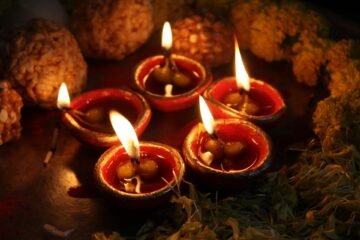
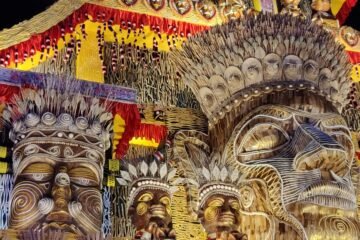
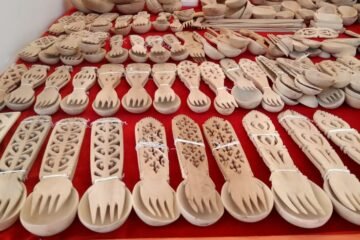
Hello. I’m interested in contacting the artisan of Molela. Pls can you share their contact details. Thank you.